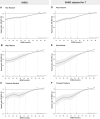Associations of Serum Testosterone and SHBG With Incident Fractures in Middle-aged to Older Men
- PMID: 39373573
- PMCID: PMC12187124
- DOI: 10.1210/clinem/dgae703
Associations of Serum Testosterone and SHBG With Incident Fractures in Middle-aged to Older Men
Abstract
Context: As men age, circulating testosterone (T) decreases, circulating SHBG increases, and the risk of fracture increases. It is unclear if circulating T, independently of comorbidities, is associated with fracture risk in men.
Objectives: To determine associations for T and SHBG with incident fractures in men.
Methods: We utilized the large (n = 205 973 participants, 11 088 any fracture cases, 1680 hip fracture cases, 1366 forearm fracture cases) and well-characterized UK Biobank cohort. Associations were modeled using Cox regressions, adjusting for multiple comorbidities/covariates, imputing for missing information, and assessing nonlinearity using cubic splines.
Results: For T, not considering SHBG, there was a nonlinear association with hip but not forearm fractures, with the lowest risk in the second quintile. However, in models adjusted for SHBG or using calculated free T, lower T was associated with a higher risk for fractures at all evaluated bone sites. Lower SHBG was strongly associated with a lower risk of hip and forearm fractures (Q1 vs Q5, hip 0.55, 0.47-0.65; forearm 0.62, 0.52-0.74).
Conclusion: Low circulating SHBG is strongly associated with a low risk of fracture at all evaluated bone sites, while the associations of circulating T with fracture risk are of lesser magnitude, nonlinear, inconsistent among fracture site, and affected by adjustment for SHBG. These findings demonstrate that circulating SHBG, rather than T, is a major independent biomarker of fracture risk in men. Consequently, both total T and SHBG should be assessed when examining the relationship of endogenous T concentrations with fractures in middle-aged to older men.
Keywords: SHBG; incident fractures; men; testosterone.
© The Author(s) 2024. Published by Oxford University Press on behalf of the Endocrine Society.
Figures


Comment in
-
The Complex Interplay of Sex Steroids and Sex Hormone-Binding Globulin in Determining Fracture Risk in Men.J Clin Endocrinol Metab. 2025 Jul 15;110(8):e2787-e2788. doi: 10.1210/clinem/dgae742. J Clin Endocrinol Metab. 2025. PMID: 39423298 No abstract available.
References
-
- Kanis JA, Johnell O, Oden A, et al. Long-term risk of osteoporotic fracture in Malmo. Osteoporos Int. 2000;11(8):669‐674. - PubMed
-
- Hsu B, Seibel MJ, Cumming RG, et al. Progressive temporal change in Serum SHBG, but not in serum testosterone or estradiol, is associated with bone loss and incident fractures in older men: the concord health and ageing in men project. J Bone Miner Res. 2016;31(12):2115‐2122. - PubMed
MeSH terms
Substances
Grants and funding
LinkOut - more resources
Full Text Sources
Medical
Research Materials
Miscellaneous

